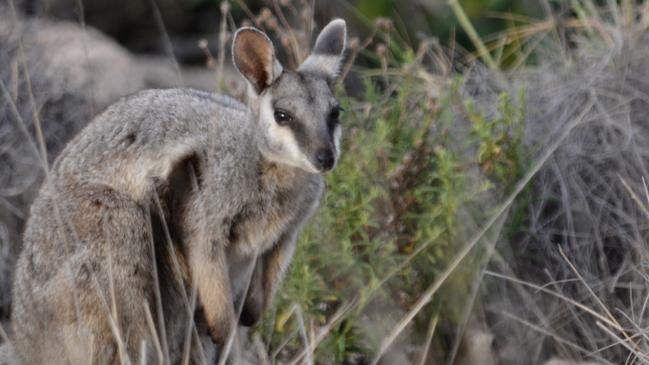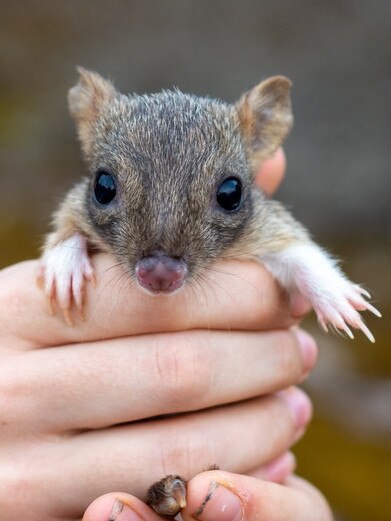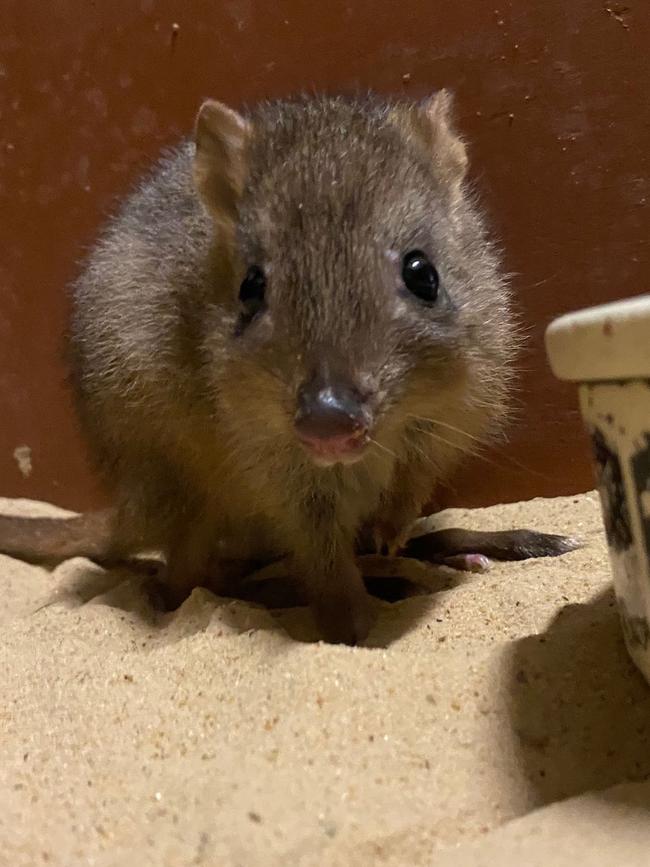How SA woman Claire Hartvigsen-Power and a brush-tailed Bettong named Rambo are saving endangered Aussie species
The Adelaide Zoo is a place for fun and families – but as it turns 140, behind the scenes there’s a life-and-death struggle.
SA Weekend
Don't miss out on the headlines from SA Weekend. Followed categories will be added to My News.
Ady (short for Adelaide) the sea lion lifts her head above the water, seems to stare straight at us, blows out some spray and then heads back underwater, her companion in the habitat, Tasko, following close behind.
“There have been a few days when I’ve wished I was her,” says Claire Hartvigsen-Power with a laugh as we stand in the middle of Adelaide Zoo, a few days after the city was torched by a three-day heatwave.
Today is a lot cooler, but still a little muggy.
A couple feeds a child under the shade of a nearby tree. An Australian white ibis meanders slowly nearby on the hunt for scraps.
It’s early in the week and the zoo is free of the normal weekend rush.
In a few short months Adelaide Zoo will be celebrating its 140th anniversary. Its status as one of the city’s key tourism attractions is undisputed (it has won top local tourism industry gongs for the past five years, entered the Hall of Fame in 2019 and it attracts upwards of around half a million visitors a year).
Lesser known, perhaps, is its role as one of the state’s key conservation institutions.
As we speak, the zoo has 26 conservation priorities, both nationally and internationally, while working on scores of other projects as a partner. And Hartvigsen-Power, when she’s not dreaming of being a sea lion, is at the centre of a fair chunk of these.

Growing up on a rural property outside of Strathalbyn, Hartvigsen-Power had a natural affinity for the environment.
“I grew up out in the bush,” she says.
“My parents are both environmentalists. We just spent my whole childhood camping or being outdoors and my parents instilled those values in me from a really young age.
“And then I reached a point where I thought ‘I’d better do something about this’.”
So she did.
Now, as Zoos SA’s conservation ecologist, she’s been at the forefront of some of the key reintroduction and research projects helping the state’s endangered and threatened species in recent years. Think wallabies facing extinction in the APY Lands that are then bred from scratch at the zoo.
Or the reintroduction of the brush-tailed bettong, which had not existed in the wild in mainland South Australia for more than a century, back on to the Yorke Peninsula.
Or research into a Kangaroo Island dunnart population devastated by bushfire.
The list goes on (and it’s a pretty long list).
Look at any corner of the state and you’ll likely find a native species under pressure and Claire Hartvigsen-Power’s job is to do what she can to help change that equation.
Zoos SA by no means plays a lone hand in this, nor does it pretend to. It clearly values its role as a team player. All projects are a diverse and at times complex mix of government agencies, private landowners, traditional owners, rangers and local landscape boards.
Many of the projects are long-running and wide in their scope.
But as a key player in the conservation space and a leader in the breeding of threatened species, Zoos SA has a very big seat at the table.
“It’s special to be able to do this sort of work,” Hartvigsen-Power says.
“And without trying to sound corny, I do feel like this is my life’s purpose.
“This is what I really need to be doing.”
Children from local schools arrive to mark the moment. Songs are sung. Stories told.
The reintroduction of the endangered “warru” into the Everard Ranges in the northern APY Lands for the first time in six decades is a landmark moment for the traditional owners, the Anangu.
They had seen the numbers of the black-flanked rock wallaby, the warru, critically reduced since the ’60s. As recently as 15 years ago, it was near extinction.
The marsupial, now the state’s most endangered mammal, is an integral part of their culture and Tjukurpa (dreaming). Its loss has been devastating.
It’s late 2022 as a group of 40 warru, taken from both the Pintji and the nearby wild population in the Musgrave Ranges, are translocated to the Everard Ranges near the community of Mimili.
“We have been waiting a while for this project to happen but we are really happy,” says Kevin Tjami, APY Antara/Sandy Bore IPA ranger, in a video shot at the time.
It’s not their first rodeo but a significant one, and a team effort involving the warru recovery team, which alongside the Anangu community included local warru rangers, traditional owners, members of the APY Land Management team and Alinytjara Wilurara Landscape Board, and Zoos SA.
For the latter, it is a continuation of a major breeding project more than 15 years in the making.
Zoos SA has been working on the program since 2006 and through an intensive ex situ breeding program at Adelaide Zoo and Monarto Safari Park, which has built up a population virtually from scratch.

Previously, numbers were released inside a feral-proof fenced area, known as the Pintji, in the APY (Anangu Pitjantjatjara Yankunytjatjara) Lands.
This was a resounding success, allowing the population to grow in relative safety and, now, to be relocated.
The wallabies, who are all fitted with radio tracking collars, will be monitored by rangers.
It is a milestone for the warru but also rangers from the nearby Mimili community, who are trained in the tracking program and have come together to ensure the marsupial’s ongoing safety.
“Being a ranger is important work,” Grant Nyaningu, a long-term warru ranger who helped build the Pintji, tells the Alinytjara Wilurara Landscape Board’s Palya! magazine.
“The old people told us to get around the land and look after the land.
“Now the old people are happy because the warru population is growing.
“Old people love to see young people working on lands and protecting their own lands and looking after country.”
Tjami releases one wallaby into a rocky outcrop, where it will be left alone to adjust to its new surrounds and then monitored by the rangers.
A short while later Adrian Dodd, a member of the land management committee, uses tracking equipment to listen to between 12 and 15 warru at the base of a hill where they are released.
“And on this hill, I am listening to hear them breathe, their home is at the top … young people looking after country,” Dodd says.
He later stands outside a cave at the top of the hill. “This is the euros’ (common wallaroo) home now,” he says.
“But one day it will be full up of warru.”
The next day a plane ride surveys the region.
“We went flying. It was a beautiful, beautiful sunrise,” Dodd says. “They’ve gone into their homes, they’re living in the bush. I could see those hills and into the valleys. Everyone is happy. Lots of Anangu are happy.”
Hartvigsen-Power is there on the day and, speaking a few months later, describes the privilege of being so closely involved with the project and the community it affects.
“Warru are so important, both ecologically and in Anangu culture so having them returned to the mountain ranges where they’ve been absent for so long was an incredibly special moment and memory for the community,” she says.
From here, the wallabies will continue to be tracked and monitored.
Hartvigsen-Power and a small team from the zoo will continue to assist with the monitoring this year. “The next plan is just to remove radio tracking collars and, in the meantime, synthesise the data, so to see how those animals are settling,” she says.

She says the ongoing success of the program is due to it being driven by Anangu traditional owners and the fact that the partners, such as Zoos SA, continue to listen and learn.
“One example of this is our agreement that any animals that come into captivity at the zoo are always returned to country,” she says.
“Whether that’s in their life span, if they are able to return to the wild or, if they aren’t, we actually repatriate their bodies. This is extremely important to that community.
“More broadly, the project is led by Anangu, the traditional custodians, the elders, the rangers. We are partners in this process but we are not driving it. The driving force is the Anangu community.”
From here, she says, there is no real end point. “You can’t really just pop the animals there and walk away within a year,” she says.
“You need to go back and ensure they’re going okay.” And she’s not just speaking about the project.
There are few things that get Claire Hartvigsen-Power quite as animated as when she is talking about the brush-tailed bettong. Its writ large on her face while holding the zoo’s own Rambo during a photo shoot for this story.
“I’m really excited about this one,” she says of the project.
“There’s so many things happening this year, but this is really how I’m benchmarking my year.”
The bettong had not existed in the wild in mainland South Australia for more than a century.
As part of the Marna Banggara rewilding project, spearheaded by the Northern and Yorke Landscape Board and the World Wide Fund for Nature Australia (WWF Australia), Zoos SA was contracted to help with the species reintroduction into Dhilba Guuranda-Innes National Park on the Yorke Peninsula (Marna Banggara, meaning “healthy/prosperous country” in Narungga language, is a 20-year project to reintroduce more native and locally extinct species back into the Yorke Peninsula).
“We carried out a pilot study in 2021 and released a small number of animals and we saw really good results with that,” Hartvigsen-Power says.
“We had animals that were breeding and settling into the environment.
“We then had animals born on the Yorke Peninsula which then creates that next generation.”


Phase one happened last year when a larger number of bettongs were introduced from a population in Western Australia, and from Wedge Island off the coast of South Australia.
“That was a lot of work, I think I’m still recovering from it,” Hartvigsen-Power says, explaining that most of the work has to be done at night for the creatures, which are nocturnal. “We work on the animals’ time frame.”
Now it’s time for phase two, which will involve a team flying back to a different region of WA for five to six nights, trapping, checking and then processing a new batch of about 80 of the animals for relocation to SA, which will take the total number of reintroduced animals to 200.
There is a bettong breeding program at the zoo, but Hartvigsen-Power says relocation is preferred in this case, simply because the WA genetics are “really, really good”.
Also, the zoo’s work, at least at this point, is purely for an insurance, break-glass-in-emergency, situation.
“We’re looking at taking some animals again from a sanctuary area,” she says.
“We’re not breeding for release here.
“The population is going quite well and there’s a sanctuary area with a large, fenced, predator-free area, and they’re happy for us to come and harvest some animals, because it’s starting to reach capacity. It’s a good partnership.”

Another project close to Hartvigsen-Power and the zoo’s heart is the work being done on Kangaroo Island to protect the Kangaroo Island dunnart, which had an estimated 96 per cent of its habitat devastated in the
2019-2020 bushfires, dramatically impacting its population.
Hartvigsen-Power says they are continuing to monitor numbers of the endangered species on the island and were over the moon in October 2021 to discover a female dunnart, with her pouch full of babies.
Unlike the warru, they haven’t yet started a breeding program; at this point they haven’t needed to, but it’s early days and the data is still being collected through a series of means, including radio-tracking.
“Where we are now is probably similar to where we were with the warru in the early days,” she says.
“But you have to study the species in the wild first and the knowledge you gain informs the entire process of bringing the animals into the zoo, or if that is necessary at all.
“Captive breeding programs and insurance populations are an important tool in the conservation toolkit, but they involve a lot of careful planning and research before we go ahead with them.
“But at this point we are very hopeful for the future of that population in the wild, certainly a lot more hopeful than we were in the months after the fire, but it all takes time.”
Then there’s the Mallee emu-wren, tiny birds (they weigh about the same as a teaspoon of sugar) whose populations were wiped out from their grassy SA habitats during the
2013-14 bushfires.
This plan saw a number of the birds relocated from Victoria to their previous SA native range in 2018. The zoo is now researching whether it needs to breed its own population.
“We are planning on bringing them into captivity this year to understand a bit better how they go in a zoo environment,” she says.
“And asking the question that, if they’re not established, how we can potentially swoop in at the last minute and protect that species.
“To do that, we need to understand how to care for them in captivity.”
The list goes on.
Claire Hartvigsen-Power’s message is pretty simple.Yes, Adelaide Zoo attracts tourists. Yes, it is good for the state economy.
But it’s no amusement park.
“I think the conservation work we do can easily be overlooked,” she says.
“Even before I started here, I was working as an ecologist and I thought I knew a little bit about it. But the truth is, I didn’t.
“It drives a lot of us, it drives a lot of what we do and I think it’s really, really important.”
Zoos SA chief executive Elaine Bensted agrees, saying their mission is two-fold, and relatively straightforward – to connect people with nature and save species from extinction.
“We believe these two actions are mutually dependent on each other,” she says.
“The role of the modern zoo has changed enormously over the years, and here at
Zoos SA our sites, Adelaide Zoo and Monarto Safari Park, are local and global conservation agencies.
“While many people see the day-to-day happenings at our sites, there is a huge amount of work that goes on behind the scenes.”

Bensted points to the work, with partners, bringing back species such as the scimitar-horned oryx and the orange-bellied parrot from the brink of extinction.
“Despite an impressive herd at Monarto Safari Park, the former is classified as extinct in the wild, while at one point, there were less than 20 of these little birds left in the wild,” Bensted says.
“I am enormously proud of the work of our dedicated team across both sites.
“If it wasn’t for them, there would be many native species that simply wouldn’t exist.
“As a not-for-profit organisation, we exist to secure a safe, long and thriving future for animals around the world – big or small, fluffy or scaly – and we are only able to continue this vital work thanks to our passionate supporters and the South Australian community.”
For Hartvigsen-Power, the work is also deeply personal.
“As an ecologist, conservation and the environment are my main drivers and passions,” she says. “And that can tend to be overwhelming. Often we focus on the doom and gloom.
“Every news story you see another bad thing happening in the environment, or the effects of climate change, or another devastating bushfire, or flood, or another species going extinct.
“But by doing this I feel like I can just put my head down and do a little bit to help things along.”



